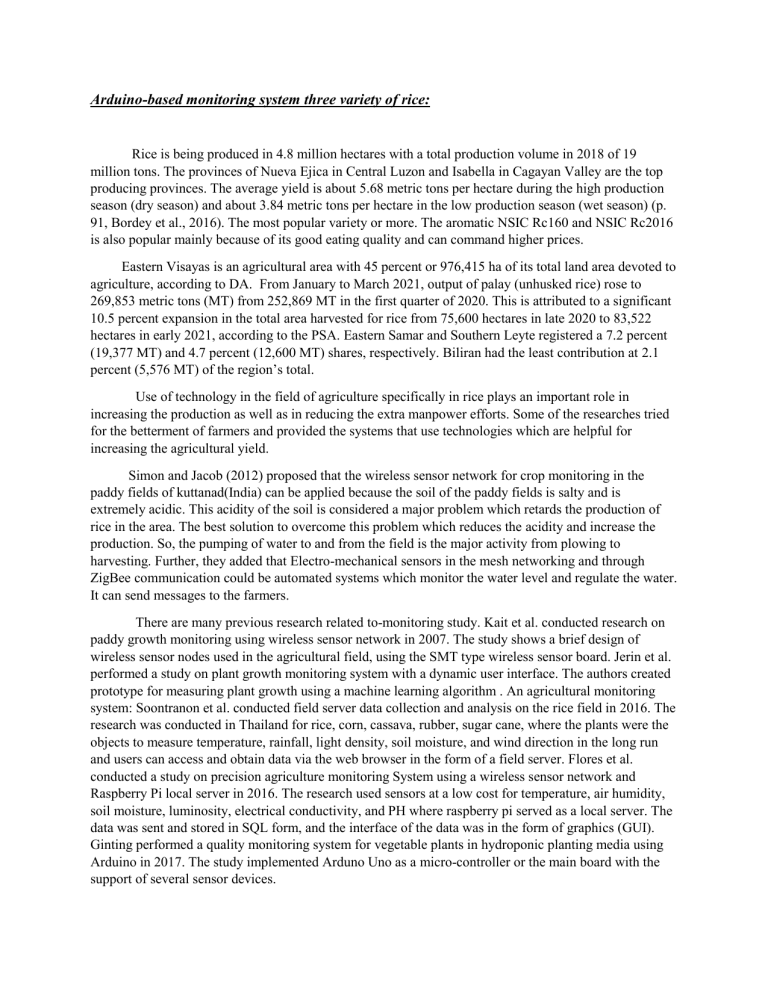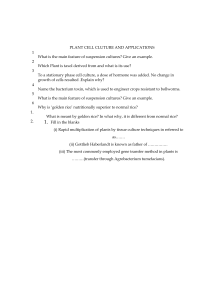
Arduino-based monitoring system three variety of rice: Rice is being produced in 4.8 million hectares with a total production volume in 2018 of 19 million tons. The provinces of Nueva Ejica in Central Luzon and Isabella in Cagayan Valley are the top producing provinces. The average yield is about 5.68 metric tons per hectare during the high production season (dry season) and about 3.84 metric tons per hectare in the low production season (wet season) (p. 91, Bordey et al., 2016). The most popular variety or more. The aromatic NSIC Rc160 and NSIC Rc2016 is also popular mainly because of its good eating quality and can command higher prices. Eastern Visayas is an agricultural area with 45 percent or 976,415 ha of its total land area devoted to agriculture, according to DA. From January to March 2021, output of palay (unhusked rice) rose to 269,853 metric tons (MT) from 252,869 MT in the first quarter of 2020. This is attributed to a significant 10.5 percent expansion in the total area harvested for rice from 75,600 hectares in late 2020 to 83,522 hectares in early 2021, according to the PSA. Eastern Samar and Southern Leyte registered a 7.2 percent (19,377 MT) and 4.7 percent (12,600 MT) shares, respectively. Biliran had the least contribution at 2.1 percent (5,576 MT) of the region’s total. Use of technology in the field of agriculture specifically in rice plays an important role in increasing the production as well as in reducing the extra manpower efforts. Some of the researches tried for the betterment of farmers and provided the systems that use technologies which are helpful for increasing the agricultural yield. Simon and Jacob (2012) proposed that the wireless sensor network for crop monitoring in the paddy fields of kuttanad(India) can be applied because the soil of the paddy fields is salty and is extremely acidic. This acidity of the soil is considered a major problem which retards the production of rice in the area. The best solution to overcome this problem which reduces the acidity and increase the production. So, the pumping of water to and from the field is the major activity from plowing to harvesting. Further, they added that Electro-mechanical sensors in the mesh networking and through ZigBee communication could be automated systems which monitor the water level and regulate the water. It can send messages to the farmers. There are many previous research related to-monitoring study. Kait et al. conducted research on paddy growth monitoring using wireless sensor network in 2007. The study shows a brief design of wireless sensor nodes used in the agricultural field, using the SMT type wireless sensor board. Jerin et al. performed a study on plant growth monitoring system with a dynamic user interface. The authors created prototype for measuring plant growth using a machine learning algorithm . An agricultural monitoring system: Soontranon et al. conducted field server data collection and analysis on the rice field in 2016. The research was conducted in Thailand for rice, corn, cassava, rubber, sugar cane, where the plants were the objects to measure temperature, rainfall, light density, soil moisture, and wind direction in the long run and users can access and obtain data via the web browser in the form of a field server. Flores et al. conducted a study on precision agriculture monitoring System using a wireless sensor network and Raspberry Pi local server in 2016. The research used sensors at a low cost for temperature, air humidity, soil moisture, luminosity, electrical conductivity, and PH where raspberry pi served as a local server. The data was sent and stored in SQL form, and the interface of the data was in the form of graphics (GUI). Ginting performed a quality monitoring system for vegetable plants in hydroponic planting media using Arduino in 2017. The study implemented Arduno Uno as a micro-controller or the main board with the support of several sensor devices. To improve the rice production in Eastern Visayas or even in the whole Philippines the use of monitoring system is the one solution. Arduino technology and the use of low-cost sensors allow realtime data capture and first-hand knowledge of the evolution of physical properties such as the setting and temperature variation of construction materials.Through this technology we can monitor the variety of rice which can be helpful to the farmers and production process.
